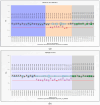Typical Clinical Presentation of an Autosomal Dominant Polycystic Kidney Disease Patient with an Atypical Genetic Pattern
- PMID: 39858586
- PMCID: PMC11764892
- DOI: 10.3390/genes16010039
Typical Clinical Presentation of an Autosomal Dominant Polycystic Kidney Disease Patient with an Atypical Genetic Pattern
Abstract
Background: Autosomal Dominant Polycystic Kidney Disease (ADPKD) is mainly characterized by renal involvement with progressive bilateral development of renal cysts and volumetric increase in the kidneys, causing a loss of renal function, chronic kidney disease (CKD), and kidney failure. The occurrence of mosaicism may modulate the clinical course of the disease. Mosaicism is characterized by a few cell populations with different genomes. In these special cases, a genetic diagnosis could be challenging. Methods: Herein, we describe the case of a 47-year-old woman presenting with typical ultrasound and computed tomography features of ADPKD. She had stage 3b CKD and hypertension. There was no family history of ADPKD, prompting an investigation with a genetic test. Target next-generation sequencing (NGS) did not detect the presence of any genomic variants. Therefore, we carried out second-level genetic analysis to investigate the presence of a large rearrangement through a multiple ligation-dependent probe amplification (MLPA) analysis of PKD1 and PKD2 genes. Results: MLPA showed a large deletion (portion including exons 2-34 of PKD1) present in the heterozygosis with a percentage of cells close to the resolution limits of the technique used (<25-30%). We concluded that the large deletion identified was mosaicism. This variant is not reported in major ADPKD databases, but due to the type of mutation and the patient's clinical picture, it should be considered as likely pathogenic. Conclusions: A stepwise genetic approach might be useful in those cases where standard methods do not allow one to reach a definitive diagnosis.
Keywords: chronic kidney disease; mosaicism; multiple ligation-dependent probe amplification; next-generation sequencing; polycystic kidney disease.
Conflict of interest statement
T.R. has received funding for lectures and has been a consultant or advisory board member for Alexion, AstraZeneca, B. Braun, Baxter, bioMérieux, Boehringer Ingelheim, Contatti (CytoSorbents), Eurofarma, George Clinical, Jafron, Lifepharma, Medcorp, Nipro, and Nova Biomedical. C.R. has been on advisory boards or speaker’s bureau for AstraZeneca, Aferetica, Asahi, B. Braun, Baxter, bioMérieux, CytoSorbents, GE, Medica, Medtronic, and Jafron. The funding sponsors had no role in the design of the study; in the collection, analyses, or interpretation of data; in the writing of the manuscript, and in the decision to publish the results. The remaining authors declare that the research was conducted in the absence of any commercial or financial relationships that could be construed as a potential conflict of interest.
Figures




References
-
- Burgmaier K., Gimpel C., Schaefer F., Liebau M. Autosomal Recessive Polycystic Kidney Disease—PKHD1. University of Washington; Seattle, WA, USA: 1993.
-
- Corradi V., Gastaldon F., Virzì G.M., Clementi M., Nalesso F., Cruz D.N., De Cal M., Torregrossa R., Ronco C. Studio epidemiologico e molecolare sulla malattia autosomica dominante del rene policistico (adpkd) nella provincia di vicenza: Possibile effetto fondatore? Epidemiological and Molecular Study of Autosomal Dominant Polycystic Kidney Disease (Adpkd) in the Province of Vicenza (a Region of North Eastern Italy): A Founder Effect? G. Ital. Nefrol. 2010;27:655–663. - PubMed
-
- Solazzo A., Testa F., Giovanella S., Busutti M., Furci L., Carrera P., Ferrari M., Ligabue G., Mori G., Leonelli M., et al. The Prevalence of Autosomal Dominant Polycystic Kidney Disease (ADPKD): A Meta-Analysis of European Literature and Prevalence Evaluation in the Italian Province of Modena Suggest That ADPKD Is a Rare and Underdiagnosed Condition. PLoS ONE. 2018;13:e0190430. doi: 10.1371/journal.pone.0190430. - DOI - PMC - PubMed
Publication types
MeSH terms
Substances
LinkOut - more resources
Full Text Sources
Miscellaneous

